Physical Address
304 North Cardinal St.
Dorchester Center, MA 02124
Surgical tape strips are now routinely used to close simple wounds. Tape strips can be applied by health care personnel in many settings, including emergency departments (EDs), operating rooms, clinics, and first aid stations. Advantages include ease of application, reduced need for local anesthesia, evenly distributed wound tension, no need for suture removal, no residual suture marks, minimal skin reaction, superiority for some grafts and flaps, and suitability for use under plaster casts. One main advantage of wound tape over standard sutures and wound staples is its greater resistance to wound infection. Wound closure strips are the most cost-effective means for closure of low-tension lacerations and provide results comparable to tissue adhesive.
Currently, several brands of tape with different porosity, flexibility, strength, and configuration are available. Steri-Strips (3M Corporation, St. Paul, MN) are nonwoven microporous tapes with ribbed backing ( Fig. 35.1 and ). They are porous to air and water, and the ribbed backing provides extra strength. Shur-Strip (Deknatel, Inc., Floral Park, NY) is another nonwoven microporous tape. Cover-Strips (Beiersdorf, South Norwalk, CT) are woven in texture and have a high degree of porosity. They allow not only air and water but also wound exudates to pass through the tape. Clearon (Ethicon, Inc., Somerville, NJ) is a synthetic plastic tape whose backing contains longitudinal parallel serrations to permit gas and fluid permeability. An iodoform-impregnated Steri-Strip (3M Corporation) is intended to further retard infection without sensitization to iodine. Other tape products include Curi-Strip (Kendall, Boston), Nichi-Strip (Nichiban Co., Ltd., Tokyo), Cicagraf (Smith & Nephew, London), and Suture Strip (Genetic Laboratories, St. Paul, MN). Steri-Strip S (formerly marketed as ClozeX) is a novel method of tape application which has shown benefit in surgical wounds.

Scientific studies of wound closure tapes provide some comparisons of products. Koehn showed that Steri-Strip tape maintains adhesiveness approximately 50% longer than Clearon tape does. Rodeheaver and coworkers compared Shur-Strip, Steri-Strip, and Clearon tape in terms of breaking strength, elongation, shear adhesion, and air porosity. The tapes were tested in both dry and wet conditions. Steri-Strip tape had approximately twice the breaking strength of the other two tapes in both conditions; there was minimal loss of strength in all tapes when wetted. Shur-Strip tape showed approximately two to three times the elongation of the other tapes at the breaking point, whether dry or wet. Shear adhesion (amount of force required to dislodge the tape when a load is applied at the place of contact) was slightly better for the Shur-Strip tape than for the Steri-Strip tape and approximately 50% better than for the Clearon tape. Of these three wound tapes, the investigators considered Shur-Strips to be superior for wound closure.
One comprehensive study of wound tapes compared Curi-Strip, Steri-Strip, Nichi-Strip, Cicagraf, Suture Strip, and Suture Strip Plus. All tapes were 12 mm wide except for Nichi-Strip, which was 15 mm. Each tape was compared for breaking strength, elongation under stress, air porosity, and adhesiveness. Curi-Strip, Cicagraf, and Steri-Strip exhibited equivalent dry breaking strength. However, when wet (a condition that can occur in the clinical setting), Cicagraf outperformed all tapes. All the tapes tested had similar elongation-under-stress profiles with the exception of Suture Strip Plus. This tape did not resist elongation under low or high force. Excessive elongation may allow wound dehiscence. Nichi-Strip was the most porous to air, and Cicagraf was almost vapor impermeable. Nichi-Strip and Curi-Strip had the best adherence to untreated skin. When the skin was treated with tincture of benzoin, however, Steri-Strip dramatically outperformed all other products. When all study parameters were considered, Nichi-Strip, Curi-Strip, and Steri-Strip achieved the highest overall performance rankings.
The primary indication for tape closure is a superficial straight laceration under little tension. If necessary, tension can be reduced by placing deep closures. Areas particularly suited for tape closure are the forehead, chin, malar eminence, thorax, and non–joint-related areas of the extremities. Tape may also be preferred for wounds in anxious children when suture placement is not essential. In young children who are likely to remove the tape, tape closure must be protected with an overlying gauze bandage.
In experimental wounds inoculated with Staphylococcus aureus , tape-closed wounds resisted infection better than wounds closed with nylon sutures. Tape closure works well under plaster casts when superficial suture removal would be delayed. Wound tape effectively holds flaps and grafts in place, particularly over the fingers, the flat areas of the extremities, and the trunk ( Fig. 35.2 ). Tape closure can also be applied to wounds after early suture removal, particularly on the face, to maintain approximation of the wound edges while reducing the chance of permanent suture mark scarring. Finally, because of the minimal skin tension created by tape, it can be used on skin that has been compromised by vascular insufficiency, altered by prolonged use of steroids, and in the fragile skin of the aged. For example, wounds on the pretibial area are difficult to close, especially so in the elderly because of tissue atrophy. Wound tape provides an alternative or adjunct to suture closure in this situation.
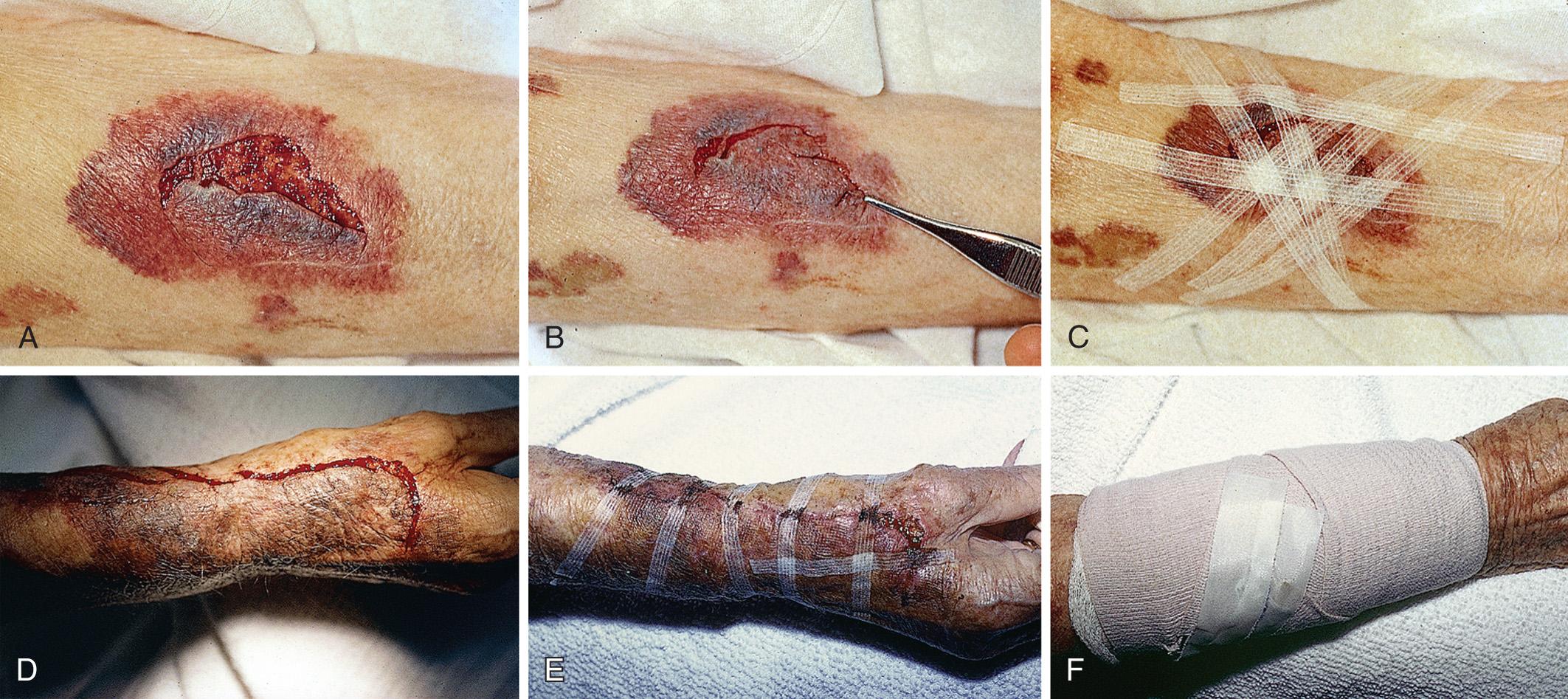
Tape closure has disadvantages as well. Tape does not work well on wounds under significant tension or on wounds that are irregular, on concave surfaces, or in areas of marked tissue laxity. In many cases, tape does not provide satisfactory apposition of the wound edges without concurrent underlying deep closure. Naturally moist areas, such as the axilla, the palms of the hands, the soles of the feet, and the perineum prevent tape from sticking well. Tape also has difficulty adhering to wounds that will have secretions, copious exudates, or persistent bleeding. It is of little value on lax and intertriginous skin, on the scalp, and on other areas with a high concentration of hair follicles. Tape strips are also at risk for premature removal by young children.
Do not place tape tightly and circumferentially around digits because it has insufficient ability to stretch or lengthen ( Fig. 35.3 ). If placed circumferentially, the natural wound edema of an injured digit can make the tape act like a constricting band, which can lead to ischemia and possible necrosis of the digit. Use semicircular or spiral placement techniques if digits are to be taped.
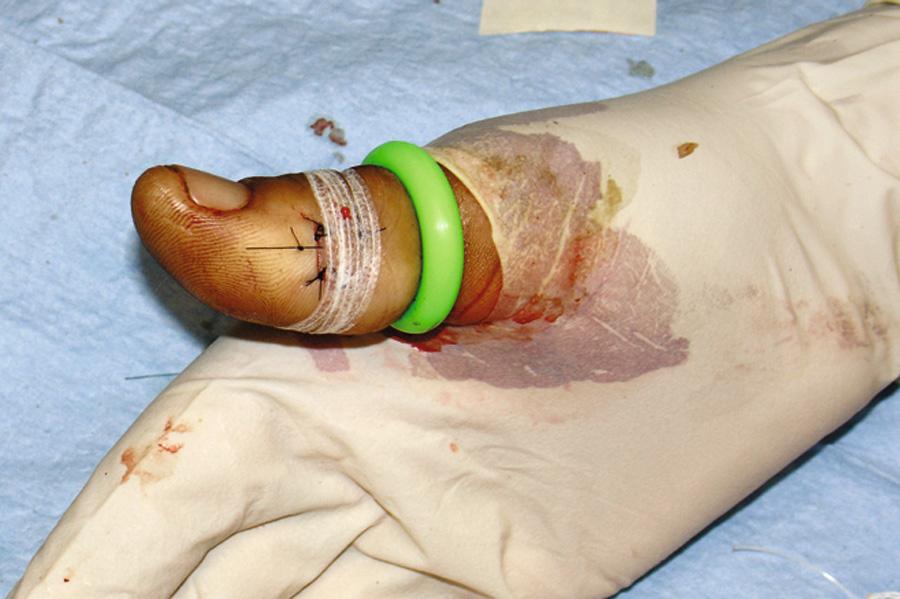
For simple tape closure, the equipment required includes forceps and tape of the proper size (see Fig. 35.1 ). Most taping can be done in the ED with 1/4-inch × 3-inch strips. For wounds larger than 4 cm, however, 1/2-inch–wide strips provide greater strength. Most companies manufacture strips up to 1 inch wide and 4 inches long.
Proper wound preparation, irrigation, débridement, and hemostasis must precede tape closure. Fine hair may be cut short. Dry the area of tape application thoroughly to ensure proper adhesion. Do not attempt to apply tape to a wet area or over a wound that is slowly oozing blood because it will usually result in failure of the tape to stick to the skin. On fingers, tape can be applied to a wound that is kept dry by temporarily placing a tourniquet at the base of the finger (see Fig. 35.3 ).
The technique of applying tape is shown in Fig. 35.4 . After the wound has been dried, apply a liquid adhesive such as tincture of benzoin or Mastisol (Eloquest Healthcare Inc, Ferndale, MI) to the skin adjacent to the wound to increase adhesion of the tape. All tape comes in presterilized packages. Open them directly onto the operating field. Handle tape with gloved hands. With the backing still attached, cut the tape to the desired length or long enough to allow approximately 2 to 3 cm of overlap on each side of the wound. After the end tab is removed, gently peel off the tape from its backing using forceps by pulling straight back. Do not pull to the side because the tape will curl and be difficult to apply to the wound. Place half of the tape securely on one side at the midportion of the wound. Gently but firmly appose the opposite wound edge to its counterpart. Apply the second half of the tape next. Hold the wound edges as close together as possible and at equal height to prevent the development of a linear, pitted scar. Apply additional tape by bisecting the remainder of the wound. Place a sufficient number of tape strips so that the wound is completely apposed without totally covering the entire length of the wound. An arrangement of tape strips parallel to each other and perpendicular to the wound provides good tape adherence over time. Finally, if using a woven tape, place additional cross strips to add support and prevent blistering caused by unsupported tape ends. Cross strips are unnecessary when using nonwoven tape, such as Steri-Strip or Shur-Strip, because nonwoven tapes have sufficient ability to elongate, which also prevents blister formation. The use of cross strips with nonwoven tape actually decreases the longevity of tape adherence.
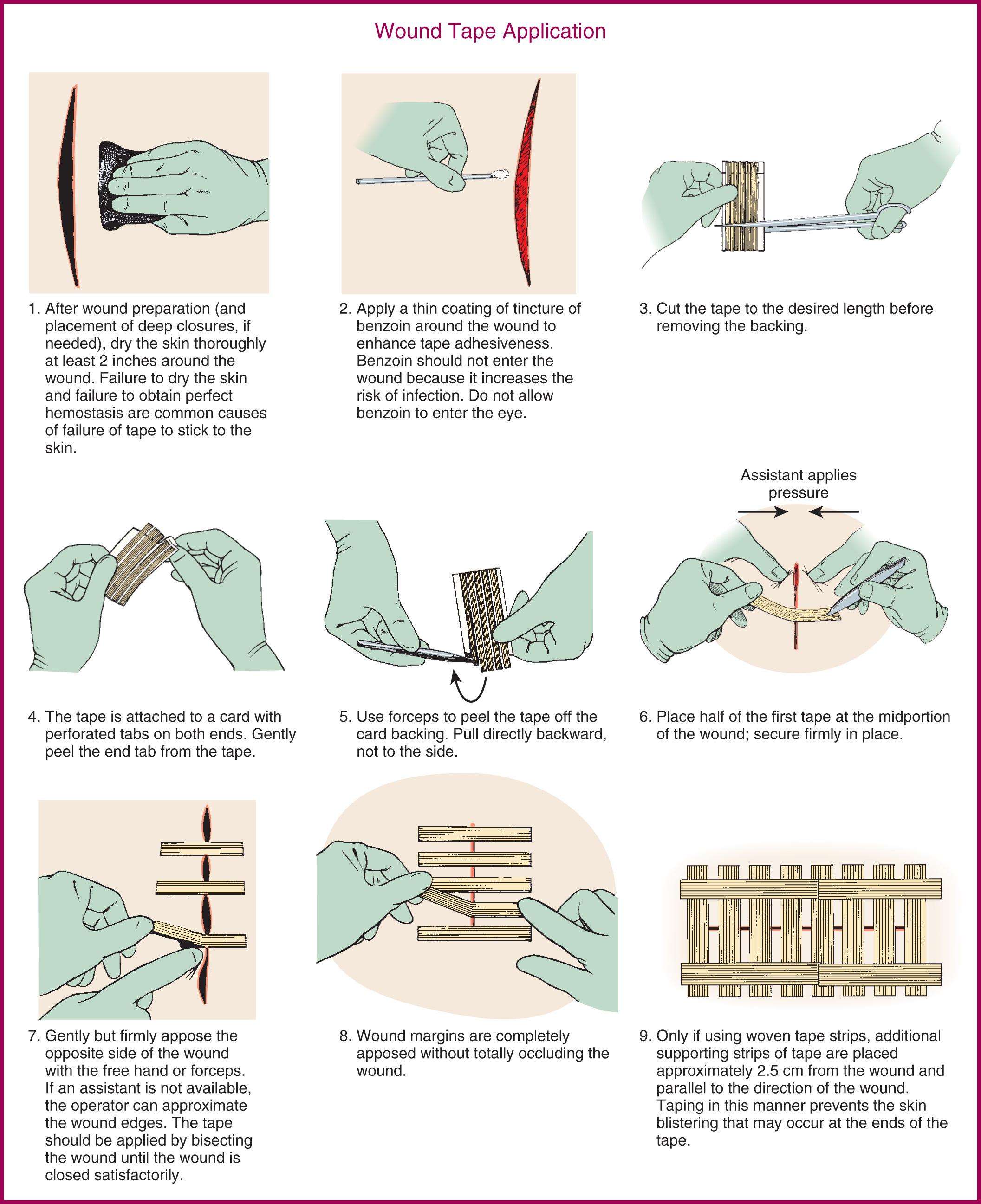
Do not cover taped wounds with occlusive dressings. Adhesive bandages (e.g., Band-Aids) and other impermeable dressings promote excessive moisture, which can lead to premature separation of tape strips from the wound. An adhesive bandage may also adhere to the tapes and pull them off the skin during dressing changes. Keep the tape in place for approximately 2 weeks or longer, if necessary. Instruct the patient to clean the taped laceration gently with a slightly moist, soft cloth after 24 to 48 hours. However, emphasize that if excessive wetting or mechanical force is used, premature tape separation may result. Instruct patients to gently trim the curled edges of the closure tape with fine scissors to avoid premature loss of the tape.
Pretibial lacerations, particularly in the aged and in those with thin skin, may be challenging to manage. Some studies of pretibial lacerations suggest using wound tape alone. However, wounds in this location are under great tension, and wound tape alone may be inadequate. Several studies have shown good results with a combination of tape and sutures. The approach by Silk showed improved healing time and decreased need for skin grafting ( Fig. 35.5 ). Steri-Strips are placed parallel to and 1 cm from the wound edges, and then 2-0 silk sutures are used to approximate the wound margins. For flap-type lacerations, an immobilizing suture placed in the middle of the flap would act much like a button, lessening the tension along the wound margins. Bain and coworkers advocate using tissue glue rather than tissue tape to support suture placement.
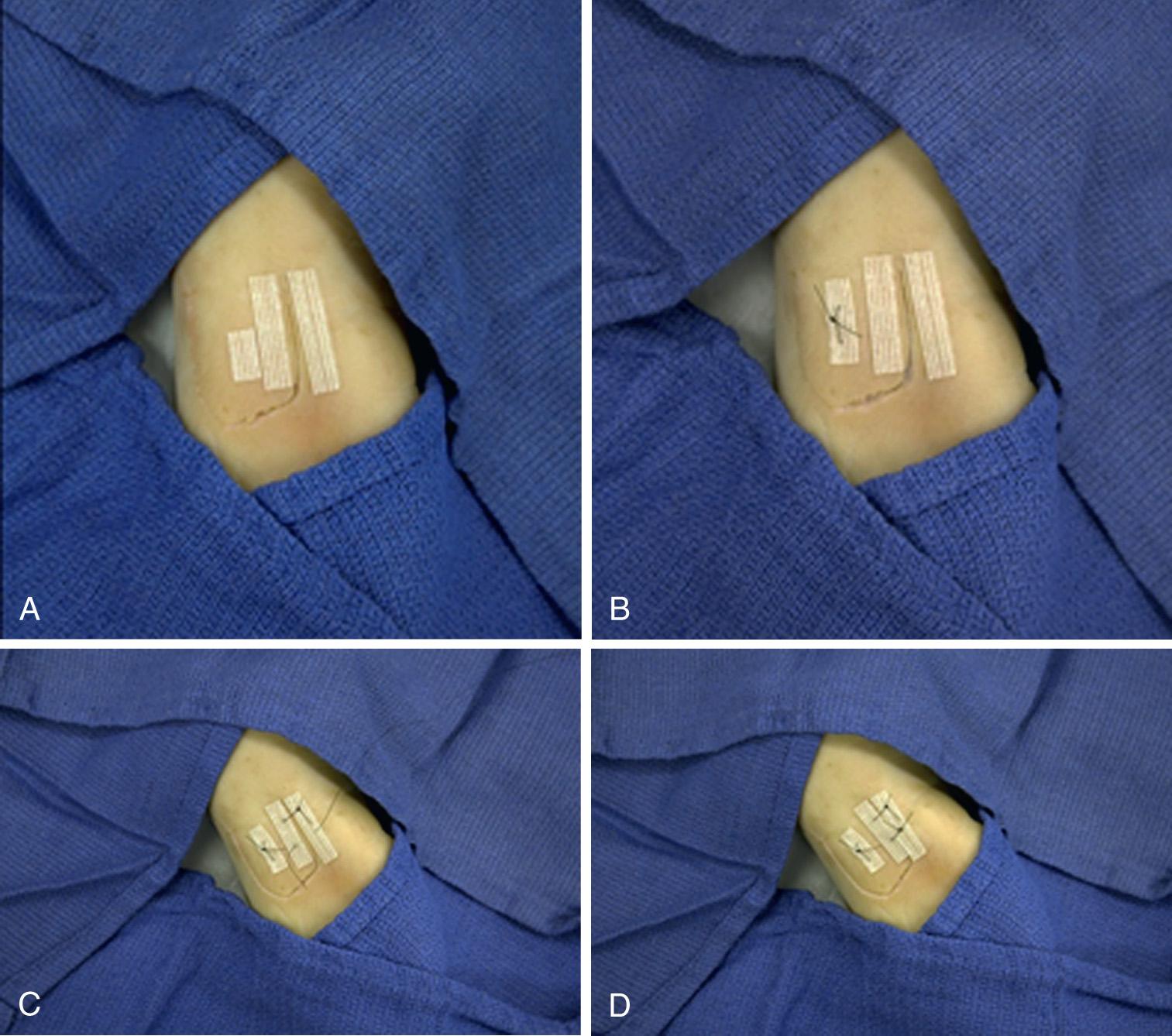
Complications are uncommon with tape closure. The wound infection rate in clean wounds closed with tape compares favorably with rates for other standard closures. The cosmetic result of closure with wound tape is comparable to other closure methods. Premature tape separation occurs in approximately 3% of cases. Other complications include: (1) skin blistering, which occurs if the tape is stretched too tightly across the wound, and (2) wound hematoma, which can result if hemostasis is inadequate. Tape may loosen prematurely over shaved areas as hair grows back.
When tincture of benzoin is used, apply it carefully to the surrounding, uninjured skin. If spillage into the wound occurs, there is a higher risk for infection. Benzoin vapor can cause pain when applied near an open wound that has not been anesthetized. Benzoin can also injure the conjunctival and corneal membranes of the eye.
Modern tape products and techniques serve a valuable role in the management of minor wounds in the ED. In selected wounds, tape closure is as successful as suture closure. Closure tape should be considered for superficial wounds in cosmetically unimportant areas and for wounds on relatively flat surfaces that are too wide for simple dressings but do not require sutures.
Tissue adhesive (also called tissue glue ) provides a simple, rapid method of wound closure that is likely underused. Tissue adhesive has been approved for use in the United States since 1998. Two types of tissue adhesive are available: 2-octylcyanoacrylate (Dermabond, Ethicon, Inc.; derma+flex QS, Chemence Medical Products, Alpharetta, GA; SurgiSeal, Adhezion Biomedical, Hudson, NC) and N -butyl-2-cyanoacrylate (Indermil, Connexicon Medical Ltd., Dublin, Ireland; Histoacryl, TissueSeal LLC, Ann Arbor, MI). LiquiBand (Advanced Medical Solutions, Winsford, United Kingdom) is a blend of an octylcyanoacrylate and butylcyanoacrylate. Animal studies have shown octylcyanoacrylate-based adhesive to have significantly greater strength and flexibility than butylcyanoacrylate-based adhesive, and Dermabond Advanced has better viscosity, as well as strength and flexibility, among the products in this catagory. Dermabond, like other tissue adhesives, is packaged in sterile, single-use ampules ( Fig. 35.6 and ). These bonding agents can be used on superficial wounds, even in hair-bearing areas. Tissue adhesives polymerize on contact with water. These substances are biodegradable but remain in the wound until well after healing. Tissue adhesive has also been shown to be useful in closure of scalp lacerations using hair apposition techniques (see later section on Scalp Lacerations ) and in both repairing nail bed lacerations and securing the nail plate to the nail bed (see later section on Nail Bed Lacerations ).
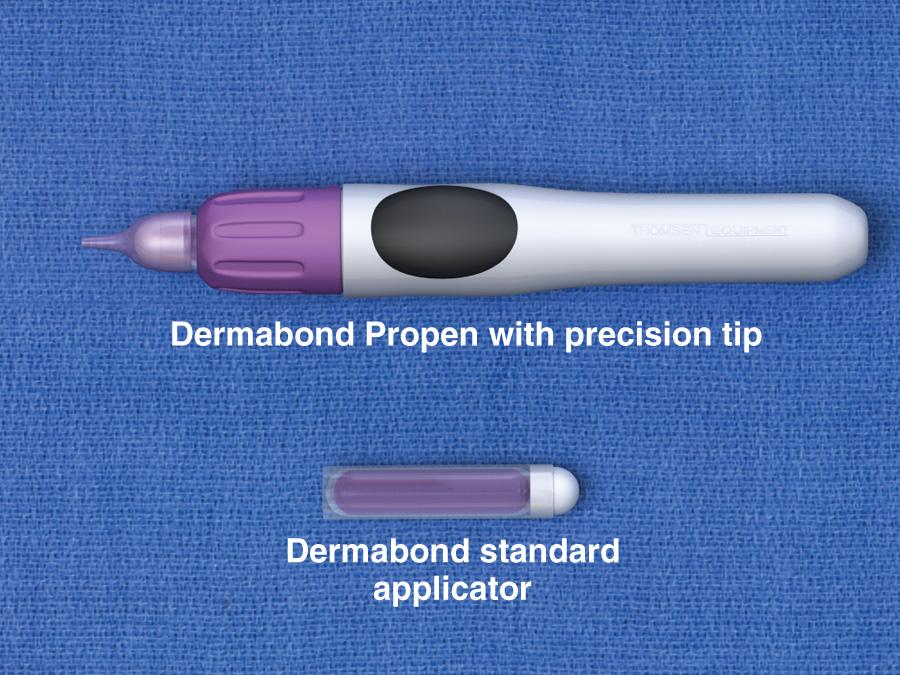
Tissue adhesive can be used to approximate wounds that do not require deep-layer closure and do not have significant tension on the edges of the wound ( Fig. 35.7 ). In preparation for closure, clean and anesthetize the wound. Débride the wound if necessary. It is especially important to control bleeding from the wound.

Hold the wound edges together with forceps, gauze pads, or fingers. Squeeze the small, cylindrical plastic container to expel droplets of tissue adhesive through the cotton-tipped applicator at the end of the container. Apply the adhesive in at least three to four thin layers along the length of the wound's surface, and extend it approximately 5 to 10 mm from each side of the wound. The purple color of the solution facilitates placement of the droplets. Support and hold the edges of the wound together for at least 1 minute while the adhesive dries. Low-viscosity tissue adhesives may seep into the wound or trickle off rounded surfaces during application. This tendency toward migration or “runoff” can be minimized by using high-viscosity adhesives (e.g., Dermabond HV Topical Skin Adhesive, Ethicon, Inc.), positioning the wound horizontally, or applying the adhesive slowly. Contain runoff with wet gauze or by creating a barrier of petrolatum.
Wound closures with tissue adhesive can be reinforced by pulling the edges of the wound into apposition with a few strips of porous surgical tape before application of the adhesive. Tissue adhesive can be placed on top of surgical tape, but tape should not be placed on top of dried tissue adhesive. Once the adhesive has dried completely, further protect the closure with a nonocclusive bandage.
Tissue adhesives can also be used to treat superficial skin tears that do not extend past the dermis. After the wound and skin flap are cleaned, lay the flap over the base of the wound and approximate the edges of the wound. Express any remaining blood and serum from under the flap, and ensure the entire area is dry. Apply a thin layer of adhesive over the wound margins and 1 to 2 cm beyond the margin. After the first layer dries, apply a second layer of adhesive. A dressing is not required unless there is a reason to protect the wound from repeated injury.
The primary advantage of tissue adhesive is the speed of closure. Wounds can be closed in as little as one-sixth the time required for repair with sutures. Application is rapid and painless. Use of tissue adhesive avoids suture marks adjacent to the wound and reduces the risk for needlestick injuries to health care personnel. Wounds closed with tissue adhesive have less tensile strength in the first 4 days than do sutured wounds, but 1 week after closure, the tensile strength and overall degree of inflammation in wounds closed with tissue adhesive are equivalent to those closed with sutures. Cosmetic results are similar to those obtained with suture repair. Tissue adhesive serves as its own wound dressing and has an antimicrobial effect against gram-positive organisms. The material sloughs off in 5 to 10 days, thereby saving the patient from another visit to a clinician. Do not apply ointments or occlusive bandages on wounds closed with tissue adhesive.
Although tissue adhesive is classified as nontoxic, some authors warn against placing it within the wound cavity. However, various investigators have applied specially formulated octyl-2-octylcyanoacrylate ( liquid adhesive bandage ) directly to open minor lacerations, abrasions, and partial-thickness wounds. Though rare, exudates, pain, tenderness, swelling, and foreign body reactions have been reported after tissue adhesive has entered the wound. When compared with adhesive bandages, wounds covered with tissue adhesive had equivalent rates of healing and complications.
If hemostasis is inadequate or an excessive amount of adhesive is applied too quickly, the patient can experience a burning sensation or sustain a local burn from the heat of polymerization. After polymerizing, tissue adhesive can fracture with excessive or repetitive movement. Although gentle rinsing is permitted, if the adhesive is washed or soaked, it will peel off in a few days, before the wound is healed.
If the clinician's gloved fingers, gauze, or plastic instruments contact the tissue adhesive during application, the glove may adhere to the patient's skin. Tissue adhesive can be removed with antibiotic ointment or petrolatum jelly or more rapidly with acetone. Indermil (Connexicon Medical) must be stored under refrigeration.
One risk involving the use of tissue adhesive is its ease of use; clinicians may fail to adequately clean wounds before closure with tissue adhesive. It should not be used to close infected wounds. There is a slightly higher risk for wound dehiscence in closures with tissue glue than with sutures.
If the edges of the wound cannot be held together without considerable tension, tissue adhesive should not be used. Percutaneous sutures provide a more secure immediate closure than tissue adhesive. It should also not be used over or near joints, on moist or mucosal surfaces, or on wounds under significant static or dynamic skin tension. See Fig. 35.7 for information on managing eyelids that are accidentally glued shut.
Automatic stapling devices have become commonplace for closure of surgical incisions and traumatic wounds ( Fig. 35.8 ). Clinical studies of patients with stapled surgical incisions have found no significant difference between stapling and suturing when infection rates, healing outcome, and patient acceptance are compared. Wound stapling ( ) and nylon suture closure of skin compared favorably in wound tensile strength, complication rates, patient tolerance, efficiency of closure, scar width, color, general appearance, suture or staple marks, infection rates, and cost. In animal models, staples caused less wound inflammation and offered more resistance to infection with contaminated wounds.
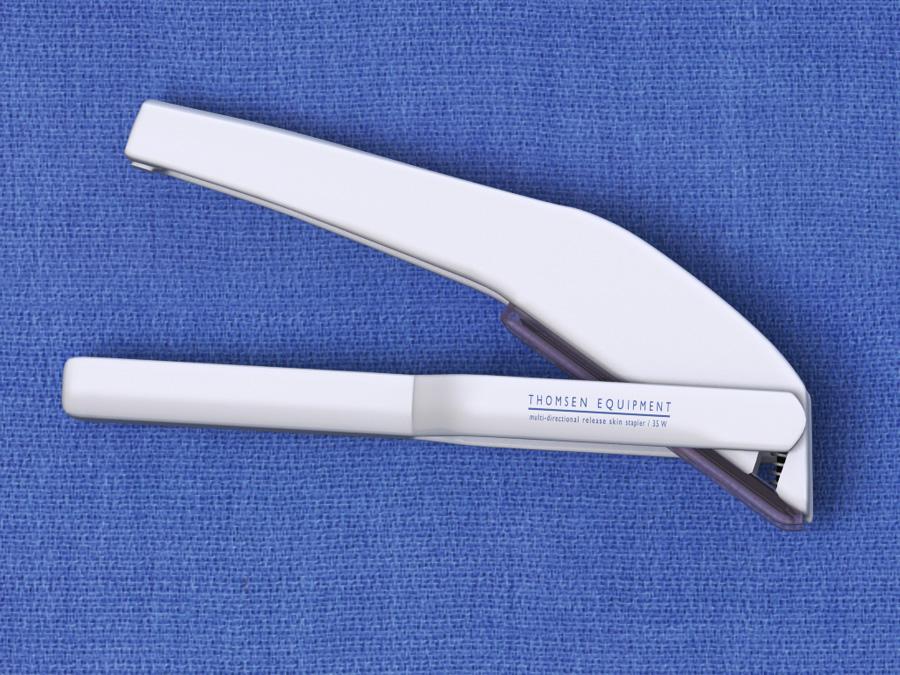
The most significant advantage of wound stapling over suturing is speed of closure. The most significant downside is loss of the cosmetic effect that can be achieved with meticulous suture closure. On average, stapling is three to four times faster than suturing traumatic wounds. When clinician time and cost of instruments are considered, the difference in cost between stapling and suturing is either minimal or favors stapling.
The indications for stapling are limited to relatively linear lacerations with straight, sharp edges located on an extremity, the trunk, or the scalp. Staples may be especially useful for superficial scalp lacerations in an agitated or intoxicated patient. Because of their superficial placement in the adult scalp (usually above the galea), staples are not recommended for deep scalp lacerations. Staples may not provide the same hemostasis that is possible with deep sutures. They should not be placed in scalp wounds if computed tomography head scans are to be performed because staples produce scan artifacts. Similarly, staples should not be used if the patient is expected to undergo magnetic resonance imaging because the powerful magnetic fields may avulse the staples from the surface of the skin. Staples should not be used on the face, neck, hands, or feet.
Standard wound care should precede wound closure. In many cases, when débridement and dermal (deep) closure are unnecessary, only tissue forceps are needed to assist in everting wounds.
Many stapling devices are commercially available. The most versatile and least expensive is the Precise stapler (3M Corporation). Different units that hold between 5 and 25 staples can be purchased. The 10-staple unit will suffice for most lacerations. Other devices include the Proximate 11 (Ethicon, Inc.), Appose (Covidien, New Haven, CT), and Reflex One (ConMed, Utica, NY).
A novel device, the Insorb (Incisive Surgical, Inc., Plymouth, MN) absorbable stapler, uses absorbable staples (made of polylactic and polyglycolic acids) placed intradermally. The device has shown both time and cost savings in repair of abdominal and breast surgical wounds comparable to intradermal sutures. The device is not widely available in the emergency setting.
Before stapling, sometimes it is necessary to place deep, absorbable sutures to close deep fascia and reduce tension in the superficial fascia and dermal layers. To facilitate the stapling process, the edges of the wound should be everted, preferably by a second operator ( Fig. 35.9 , step 1 ). The assistant precedes the operator along the wound and everts the edges of the wound with forceps or pinches the skin with the thumb and forefinger. Stapling flattened wound edges may place the staple precisely but results in inversion of the wound. Once the edges are held in eversion, the staple points are gently placed across the wound. The center of the staple device should be placed over the center of the wound to ensure the best closure and to avoid overriding or misaligned edges (which can be difficult in an uncooperative patient). When the stapler handle or trigger is squeezed, the staple is advanced automatically into the wound and bent to the proper configuration (see Fig. 35.9 , steps 2 and 3 ). The operator should not press too hard on the skin surface to prevent placing the staple too deeply and causing ischemia within the staple loop. When placed properly, the crossbar of the staple is elevated a few millimeters above the surface of the skin (see Fig. 35.9 , step 4 ). A sufficient number of staples should be placed to provide proper apposition of the edges of the wound along its entire length. (One suggested method is to place a staple in the midpoint of the length of the wound and then bisect either side of the wound with additional staples. Continue the process until the edges of the wound are well opposed.) After the wound is stapled, an antibiotic ointment may be applied. Stapled wounds may be left uncovered, or a sterile dressing may be applied. The patient can remove the dressing and gently clean the wound in 24 to 48 hours. Scalp lacerations can be cleansed by showering within a few hours.

Removal of staples requires a special instrument made available by each manufacturer of stapling devices. The lower jaw of the staple remover is placed under the crossbar, and the handle is squeezed (see Fig. 35.9 , steps 5 and 6 ). This action compresses the crossbar and bends the staple outward, thereby releasing the points of the staple from the skin. Many primary care physicians do not routinely stock the instrument. If referred to a primary care physician's office for removal of staples, the patient can be given a disposable staple removal device to bring with them. If well-instructed, patients can remove their own staples with the removal device. The interval between staple application and removal is the same as that for standard suture placement and removal. Staples can cause significant scarring if left in place too long ( Fig. 35.10 ).
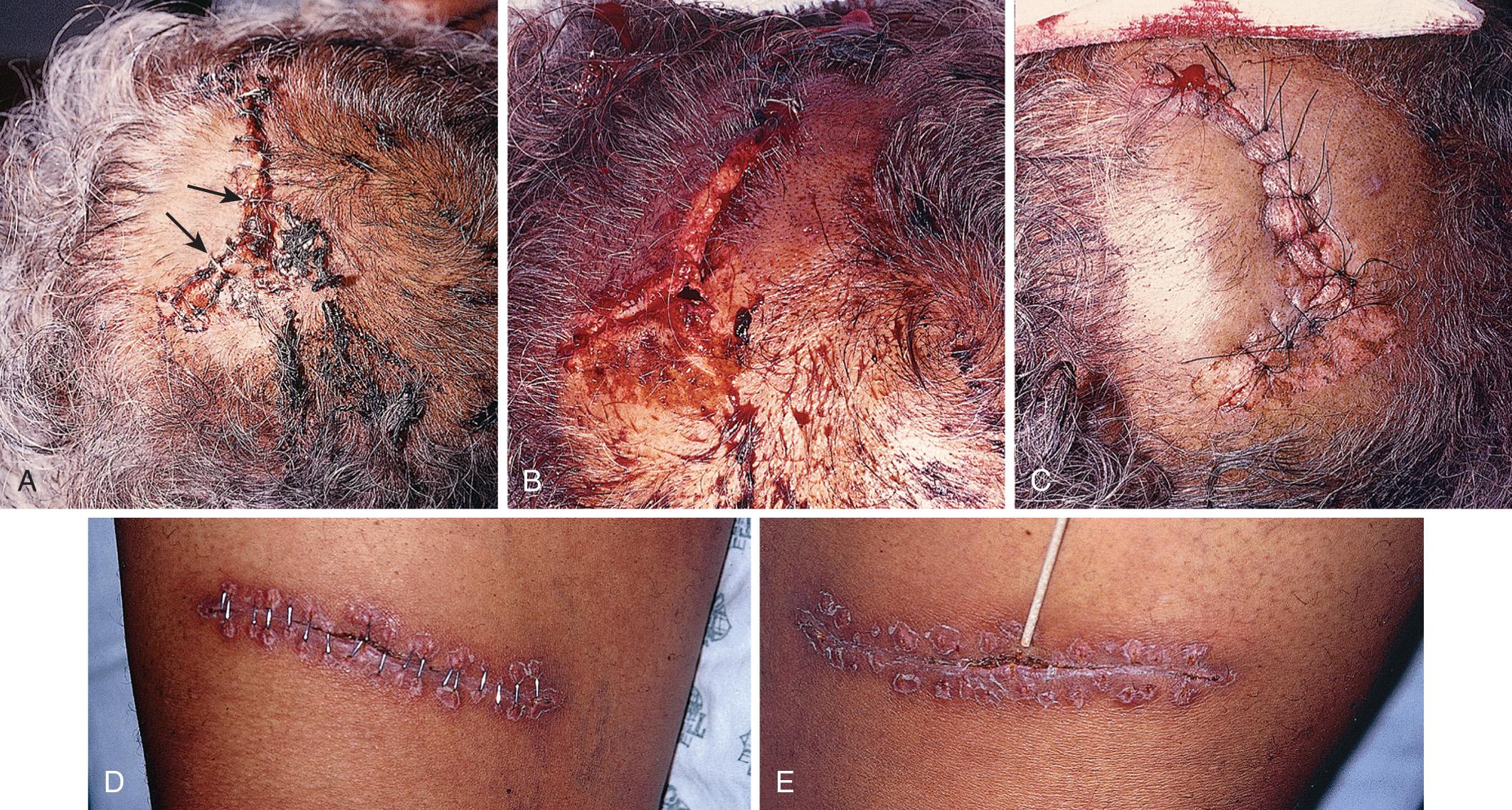
Patient acceptance, comfort, and rates of wound infection and dehiscence are similar with staple-closed wounds and sutured wounds. However, removal of staples can be somewhat more uncomfortable than removal of sutures.
A common error during insertion of staples is failure to evert the edges of the skin before stapling (see Fig. 35.10 ). Eversion avoids the natural tendency of the device to invert the closure. Eversion may be accomplished with forceps or by pinching the skin with the thumb and index finger, a procedure that requires some practice. Another common error is to fail to align the middle of the staple exactly in the midline of the wound.
Staples will cause marks in the skin that are similar to sutures. However, in patients who tend to scar more easily, the scar resulting from staples may be more pronounced than that produced by sutures, especially if the staples are left in place for prolonged periods.
Wound stapling achieves results that are generally comparable to those of sutures for the closure of traumatic, linear lacerations in noncosmetic areas, such as the scalp, trunk, and extremities. Stapling is much faster than suturing. Wound stapling does not differ significantly from suturing in terms of cost, infection rates, wound healing, and patient acceptance, but cosmesis may suffer, especially if the staples are left in too long (see Fig. 35.10 D and E ).
In the United States, most traumatic wounds are closed by suturing.
In addition to the instruments used for débridement, a needle holder and suture scissors are required for suturing ( Fig. 35.11 ). The mechanical performance of disposable needle holders distributed by different surgical instrument companies varies considerably. The size of the needle holder should match the size of the needle selected for suturing; the needle holder should be large enough to hold the needle securely as it is passed through tissue, yet not so large that the needle is crushed or bent by the instrument.
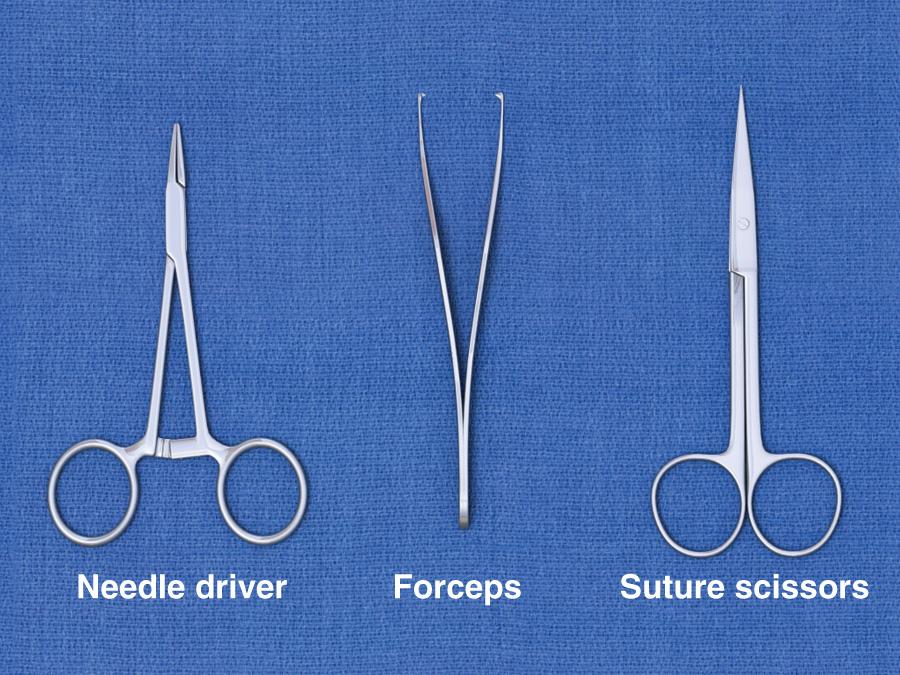
Instruments used to débride a grossly contaminated wound should be discarded and replaced with fresh instruments for closure. Instruments covered with coagulated blood can be cleansed with hydrogen peroxide, rinsed with sterile saline or water, and then used for suturing.
In addition, 2.5 loupe magnification may improve inspection of wounds and facilitate the repair of facial and hand wounds.
A wide variety of suture material is available to satisfy clinician preferences ( Fig. 35.12 ). There are no definitive standards on which to base the use of suture material for a particular wound or site. For most wounds that require closure of more than one layer of tissue, the clinician must choose sutures from two general categories: an absorbable suture for the deeper, subcutaneous (SQ) layer and a nonabsorbable suture for surface (percutaneous) closure.
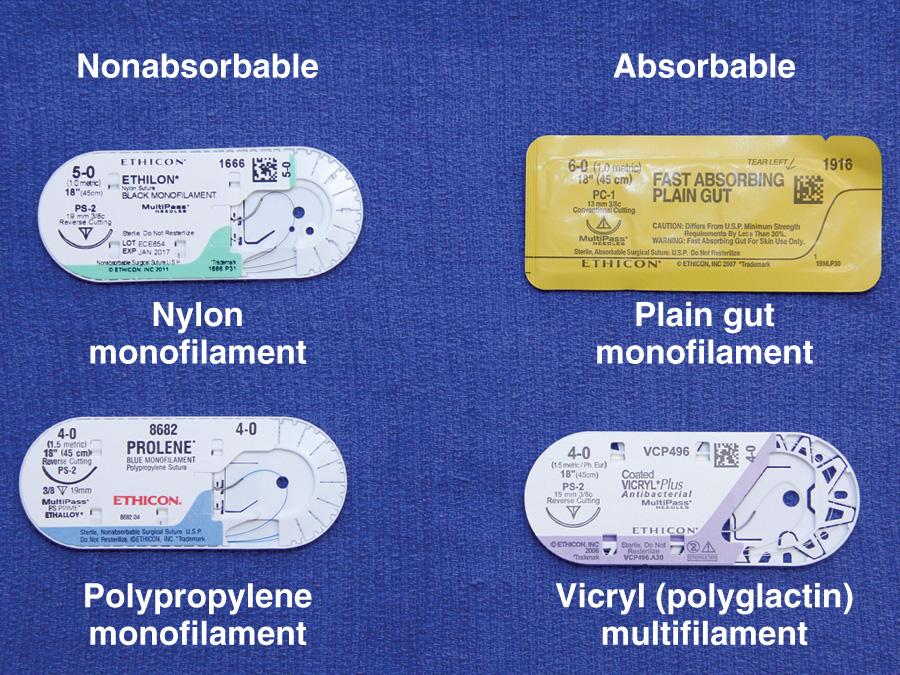
Sutures can be described in terms of four characteristics:
Composition (i.e., chemical and physical properties).
Handling characteristics and mechanical performance.
Absorption and reactivity.
Size and retention of tensile strength.
Sutures are made from natural fibers (cotton, silk), from sheep submucosa or beef serosa (plain gut, chromic gut), or from synthetic material such as nylon (Dermalon [Medtronic, Minneapolis, MN], Ethilon [Ethicon Inc.], Nurolon [Ethicon Inc.], Surgilon [Medtronic]), Dacron (Ethiflex, Mersilene [both Ethicon Inc.]), polyester (Ti-Cron [Medtronic]), polyethylene (Ethibond [Ethicon Inc.]), polypropylene (Prolene [Ethicon Inc.], Surgipro [Medtronic]), polyglycolic acid (Dexon [Medtronic]), and polyglactin (Vicryl, coated Vicryl, Vicryl Rapide [all Ethicon Inc.]). Stainless steel sutures are rarely, if ever useful in wound closure in the ED setting because of handling difficulty and fragmentation. Some sutures are made of a single filament (monofilament); others consist of multiple fibers braided together ( Table 35.1 ).
| ABSORBABLE SUTURE | NONABSORBABLE SUTURE |
|---|---|
| Monofilament | |
| Plain gut | Dermalon (nylon) |
| Chromic gut | Ethilon (nylon) |
| PDS (polydioxanone) | Novafil (polybutester) |
| Maxon (polyglyconate) | Prolene (polypropylene) |
| Monocryl (poliglecaprone 25) | Silk |
| Biosyn (glycomer 631) | Steel |
| Surgilene (polypropylene) | |
| Tevdek (Teflon coated) | |
| Multifilament | |
| Dexon (polyglycolic acid) | Ethibond (polyethylene) |
| Coated Vicryl (polyglactin 910) | Mersilene (braided polyester) |
| Nurolon (nylon) | |
| Surgilon (nylon) | |
| Ti-Cron (polyester) | |
Become a Clinical Tree membership for Full access and enjoy Unlimited articles
If you are a member. Log in here